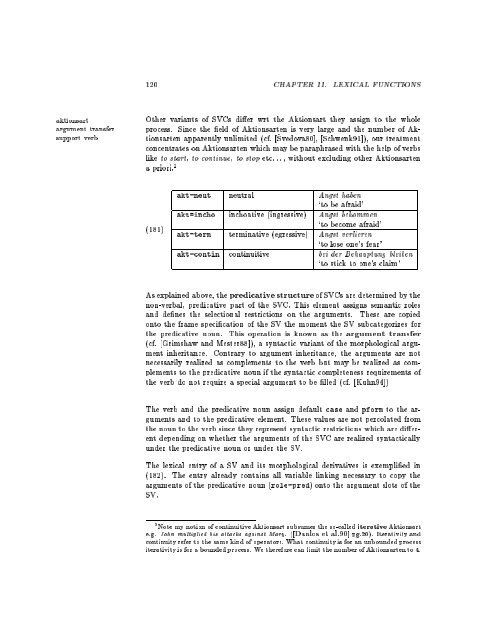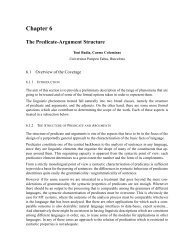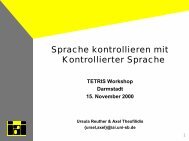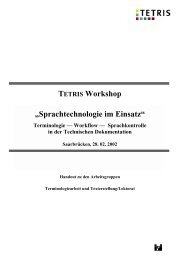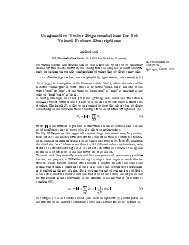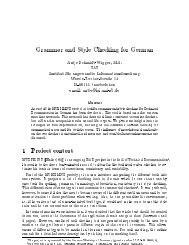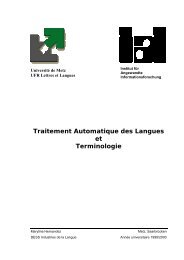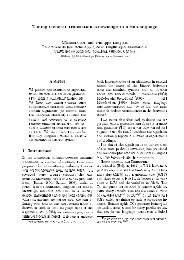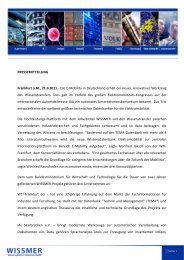Linguistic Modeling for Multilingual Machine Translation
Linguistic Modeling for Multilingual Machine Translation
Linguistic Modeling for Multilingual Machine Translation
Create successful ePaper yourself
Turn your PDF publications into a flip-book with our unique Google optimized e-Paper software.
120 CHAPTER 11. LEXICAL FUNCTIONS<br />
aktionsart<br />
argument transfer<br />
support verb<br />
Other variants of SVCs dier wrt the Aktionsart they assign to the whole<br />
process. Since the eld of Aktionsarten is very large and the number of Aktionsarten<br />
apparently unlimited (cf. [Svedova80], [Schwenk91]), our treatment<br />
concentrates on Aktionsarten which may be paraphrased with the help of verbs<br />
like to start, to continue, to stop etc:::, without excluding other Aktionsarten<br />
a priori. 2<br />
(181)<br />
akt=neut neutral Angst haben<br />
`to be afraid'<br />
akt=incho inchoative (ingressive) Angst bekommen<br />
`to become afraid'<br />
akt=term terminative (egressive) Angst verlieren<br />
`to lose one's fear'<br />
akt=contin continuitive bei der Behauptung bleiben<br />
`to stick to one's claim'<br />
As explained above, the predicative structure of SVCs are determined by the<br />
non-verbal, predicative part of the SVC. This element assigns semantic roles<br />
and denes the selectional restrictions on the arguments. These are copied<br />
onto the frame specication of the SV the moment the SV subcategorizes <strong>for</strong><br />
the predicative noun. This operation is known as the argument transfer<br />
(cf. [Grimshaw and Mester88]), a syntactic variant of the morphological argument<br />
inheritance. Contrary to argument inheritance, the arguments are not<br />
necessarily realized as complements to the verb but may be realized as complements<br />
to the predicative noun if the syntactic completeness requirements of<br />
the verb do not require a special argument to be lled (cf. [Kuhn94])<br />
The verb and the predicative noun assign default case and p<strong>for</strong>m to the arguments<br />
and to the predicative element. These values are not percolated from<br />
the noun to the verb since they represent syntactic restrictions which are dierent<br />
depending on whether the arguments of the SVC are realized syntactically<br />
under the predicative noun or under the SV.<br />
The lexical entry of a SV and its morphological derivatives is exemplied in<br />
(182). The entry already contains all variable linking necessary to copy the<br />
arguments of the predicative noun(role=pred) onto the argument slots of the<br />
SV.<br />
2 Note my notion of continuitive Aktionsart subsumes the so-called iterative Aktionsart<br />
e.g. John multiplied his attacks against Mary. ([Danlos et al.90] pg.20). Iterativity and<br />
continuity refer to the same kind of operators. What continuity is <strong>for</strong> an unbounded process<br />
iterativity is <strong>for</strong> a bounded process. We there<strong>for</strong>e can limit the number of Aktionsarten to 4.


